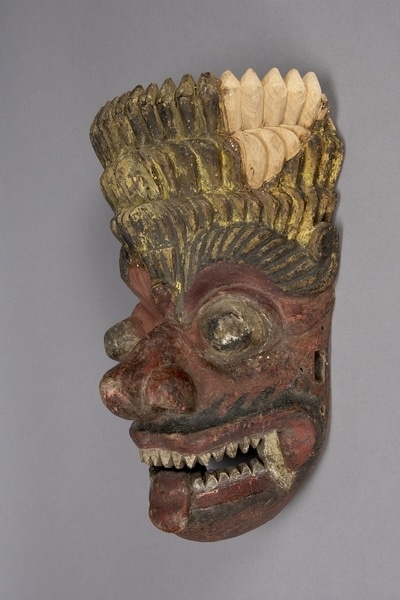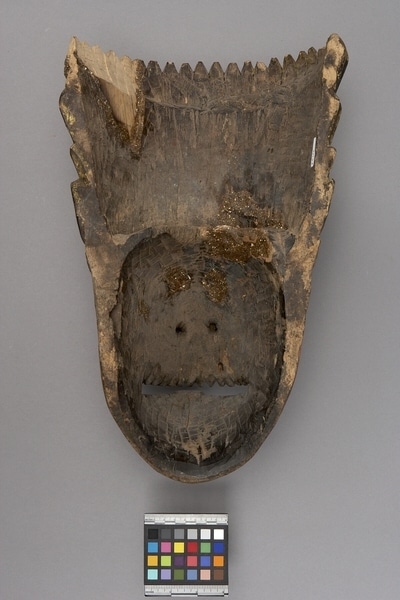Mask Item Number: Eh132 from the MOA: University of British Columbia




Description
Mask with red-brown humanoid face with a three-tiered headdress of overlapping petal-like forms. The face has heavy arched eyebrows that curl at the outer ends. The eyes are protruding and somewhat conical with rounded tops. The large nose has a bulbous tip and flared nostrils. The lips are drawn back from the teeth and are outlined with a black jagged design. Two upper and lower rows of pointed teeth are exposed with curved fangs at either side, and a tongue hangs out the front of the mouth. There is a rectangular motise hole at either side of the head, each with three small holes at top, bottom, and towards the front of the mask.
History Of Use
Maru Raksa, demon of death, may appear in several contexts of Sri Lankan dance and dRama. He takes part, with other demons, in the Kolam a series of dRamatic episodes performed primarily for entertainment. In this context, the dance of the rassayas, or demons, follows a prelude in which legendary royal figures arrive and are seated, and precedes the main body of the drama. The purpose of the demon dance is obscure. The Maru Raksa mask is also used in a series of ritualistic dance ceremonies known as the Devolmaduva and Gammaduva, in which gods and goddesses are invoked and impersonated for protective and curative purposes. In this context, the character appears in an episode known as the Mara-ipadduma, or death and resurrection, in which he kills the husband of Pattini, a goddess of chastity and purity.
Cultural Context
Ritual dance; propitiatory drama; worn by men in dancing.
Iconographic Meaning
The exaggerated size, elaborate 3-tiered headdress of petal shapes, and distorted facial features including projecting cylindrical eyes large nose with flared nostrils, lolling tongue, grimacing mouth are all distinguishing characteristics of the demons associated with the Kolam. The red-brown colour and flame-like lip outline suggest that this represents Maru Raksa, demon of death.
Item History
- Made in Pandiya, Sabaragamuwa, Sri Lanka before 1983
- Collected during 1983
- Owned by W. P. Ebert
- Owned by Jason Schoonover before June 21, 1984
- Received from Museum of Anthropology Shop Volunteers (Funding source) and Jason Schoonover (Seller) on June 21, 1984
What
Who
- Culture
- Sinhalese
- Previous Owner
- W. P. Ebert and Jason Schoonover
- Received from
- Museum of Anthropology Shop Volunteers (Funding source) and Jason Schoonover (Seller)
Where
- Holding Institution
- MOA: University of British Columbia
- Made in
- Pandiya, Sabaragamuwa, Sri Lanka
When
- Creation Date
- before 1983
- Collection Date
- during 1983
- Ownership Date
- before June 21, 1984
- Acquisition Date
- on June 21, 1984
Other
- Condition
- fair
- Accession Number
- 0972/0022